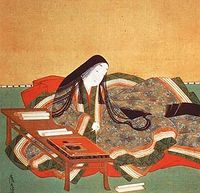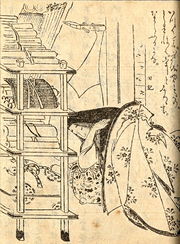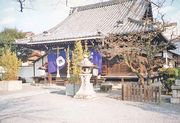Murasaki Shikibu
| Murasaki Shikibu | |
|---|---|
 Murasaki Shikibu, illustration by Tosa Mitsuoki (17th century) |
|
| Born | circa 973 Kyoto |
| Died | circa 1014 Kyoto |
| Occupation | Heian court lady-in-waiting |
| Genres | novel, poetry |
| Subjects | Japanese court customs |
| Relative(s) | Fujiwara no Tametoki, father |



Murasaki Shikibu (紫式部; c. 973–c. 1014 or 1025), or Lady Murasaki as she is often known in English, was a Japanese novelist, poet, and a maid of honor of the imperial court during the Heian period of Japan. She is best known as the author of The Tale of Genji, written in Japanese between about 1000 and 1008, considered to be the earliest novel in human history.[1]
"Murasaki Shikibu" was not her real name, which is unknown. Some scholars have postulated that her given name might have been Fujiwara Takako, recorded as a name of a lady-in-waiting ranked shōji on the 29th day of the 1st month, Kankō 4 (February 19, 1007) according to Midō Kampaku Ki, a diary written by Fujiwara no Michinaga, although this theory has not been supported by many others.[2] Her own diary, The Murasaki Shikibu Diary, states that she was nicknamed "Murasaki" ("Violet") at court, after a character in The Tale of Genji. "Shikibu" refers to her father's position in the Bureau of Ceremony (shikibu-shō).
Contents |
Biography
Lady Murasaki Shikibu was born about 973 in Kyoto, Japan. She was born in a family of minor nobility and a member of the northern branch of the Fujiwara clan.
Murasaki's mother died while she was a child, so Murasaki was raised, contrary to customs of the time, by her father Fujiwara no Tametoki, a scholar and officer of the imperial court. During Heian-era Japan, couples lived separately and children were raised by the mother and her family. Also contrary to customs of the time, her father gave her a male education. Men were taught kanji and classical Chinese literature as the requisite culture, while women were taught kana and poetry. Her father praised her intelligence and ability, but lamented that she was "born a woman". She was married in her early 20s and had one child, Daini no Sanmi, who was a poet in her own right.[3]
At the royal court, she was the lady-in-waiting for Empress Shoshi (Akiko) and may have been hired by Fujiwara no Michinaga to serve the Empress.
Murasaki died either in 1014, when records show that her father suddenly returned to Kyoto from his governor's mansion, or between 1025 and 1031, when she would have been in her mid-50s, fairly old by Heian standards.
Three works are attributed to Murasaki, the most important being The Tale of Genji. The Murasaki Shikibu Diary and The Murasaki Shikibu Collection were arranged and published posthumously. The collection is a compilation of 128 poems written by Murasaki.
Legacy and influence
Murasaki is considered one of the greatest writers of Japanese literature. Statues in her honour have been erected throughout Japan, her works are a staple part of the education curriculum in Japan. The 2000 yen note was issued in commemoration to her and her greatest epic work, The Tale of Genji. She was a lady-in-waiting for Emperor Ichijo at the time. After his death, she became the lady-in-waiting for the Empress Akiko.
A fictionalized biography of Murasaki called The Tale of Murasaki: A Novel was written by Liza Dalby. Another fictionalized biography of Murasaki Shikibu is an Italian novel by Gabriella Magrini: Mille Autunni, vita di Murasaki Dama di Corte, Edizione Frassinelli 1985; translated into French under the title La dame de Kyoto, Editions Belfond, 1987, ISBN 2 7144 1973 9. A fictitious descendant of Lady Murasaki is a major character in the Thomas Harris novel and subsequent horror film Hannibal Rising.
See also
- Sei Shōnagon - court rival and fellow contemporary diarist
- Ono no Takamura - an earlier Japanese poet whose grave is situated across from Lady Murasaki's
- The Tale of Genji - a novel (considered the world's first novel) written by Murasaki Shikibu.
References
- ↑ http://www.cbc.ca/ideas/features/tale-of-genji/index.html
- ↑ (a) Bunei Tsunoda "Real name of Murasahiki Shikibu" Kodai Bunka (Cultura antiqua) 1963, no.7. (b) Gen-e Imai "Questions on the theory of the real name of Murasaki Shikibu as Takako" Kokugo Kokubun (Japanese Language and Literature) Vol. 34 (no. 1) (1965). Both articles in Japanese.
- ↑ Kenneth Rexroth and Ikuko Atsumi, Women Poets of Japan, New Directions Press (1982) at 143.
- Dalby, Liza. The Tale of Murasaki: A Novel (Anchor, 2001). ISBN 0-385-49795-4.
- Lady Murasaki, Arthur Waley (trans.). The Tale of Genji, published in 6 volumes from 1921-33.
- Shikibu, Murasaki; Tyler, Royall (trans.). The Tale of Genji (Viking, 2001.) ISBN 0-670-03020-1.
External links
 Media related to Murasaki Shikibu at Wikimedia Commons
Media related to Murasaki Shikibu at Wikimedia Commons- Murasaki's Grave
- Murasaki Shikibu (Spanish)
- The Diary of Murasaki Shikibu
- [1]